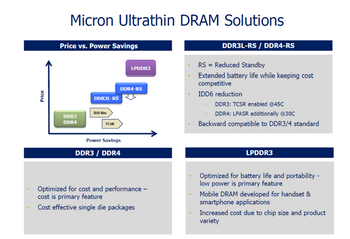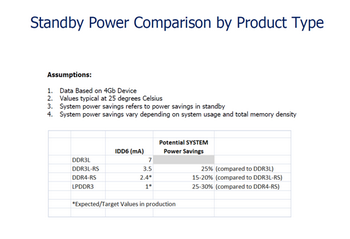OOPS! You forgot to upload swfobject.js ! You must upload this file for your form to work.
The cost and other benefits from the introduction of DDR3L-RS
![]()
|
xtreview is your : Video card - cpu - memory - Hard drive - power supply unit source |
|
|||
|
|
||||
 Recommended : Free unlimited image hosting with image editor
Recommended : Free unlimited image hosting with image editor
|
POSTER: computer news || THE COST AND OTHER BENEFITS FROM THE INTRODUCTION OF DDR3L-RS |
DATE:2012-09-23 |
|
|
This week, we reported about the release of interesting memory type DDR3L-RS, which provided almost simultaneously the company Micron ( 30-nm ) and Hynix ( 20 nm ). Let's start with how DDR3L-RS memory is positioned . Theoretically, since the mobile platform Haswell, which is especially important for ultrabooks, in the PC promises to appear memory type LPDDR3 . At the same time, LPDDR3 memory raise the price of the system, which runs counter Intel desire to steadily reduce the base ultrabook cost . As a compromise to balance the cost, power consumption and capacity of main memory can be a choice of memory manufacturers DDR3L-RS.  Micron Estimated, cost of chips DDR3L-RS will be 20% more than DDR3L. The latter, in turn, only 10% more pervasive than DDR3 memory. LPDDR3 Memory will steadily remain expensive for quite some time, as demand for smartphones and tablets will not leave surplus for the computer market. Thus, the DDR3L-RS memory will be more expensive than DDR3 by about 30%, but its more economical. By how much? In idle mode DDR3L-RS memory system will save up to 25% energy, according Micron. In working state DDR3L-RS memory will consume as much as DDR3 memory.  Based on measurements of its temperature, cooled down in idle mode and 45 degrees Celsius memory DDR3L-RS reduces the intensity of updating data and, as a result, the value of current IDD6 (self-refresh). Through DDR3L-RS memory is saving energy . Cold crystals do not require such intensive regeneration cycle, as hot as the current DDR3 standard requires the update mode for 85 degrees, which can be observed in practice, not always. Clearly, the gain from using DDR3L-RS will give a significant effect only in the case of mobile systems. Related Products : | ||
|
|
||
|
xtreview is your : Video card - cpu - memory - Hard drive - power supply unit source |
|
|
|
|
||
|
Xtreview Support  N-Post:xxxx Xtreview Support        |
THE COST AND OTHER BENEFITS FROM THE INTRODUCTION OF DDR3L-RS |
| Please Feel Free to write any Comment; Thanks  |
Memory manufacturers increased capital costs this year (2017-09-04)
Sony reduces the cost of PlayStation VR kits (2017-08-29)
IPhone 8 will cost a minimum of 999 dollars (2017-08-28)
The cost of batteries for laptops will grow by 20 percents (2017-08-15)
Video card Radeon RX Vega 64 could cost 100 dollar cheaper (2017-08-15)
The head of NVIDIA admitted that Volta costs a lot in production (2017-08-11)
The younger processor Socket AM4 costs only 47 dollars (2017-08-01)
Autonomous helmet virtual reality Oculus will cost 200 dollars (2017-07-14)
cost of Android-smartphone YotaPhone 3 (2017-06-18)
The cost of Android-smartphone OnePlus 5 will be 479 dollars (2017-06-14)
Preliminary data on the cost of Intel Skylake-X and Kaby Lake-X processors (2017-05-30)
The average price of a GeForce video card is three times lower than the cost of a gaming console (2017-05-10)
AMD increases the cost of developing new products and technologies (2017-05-02)
In the structure of each car, the cost of semiconductors draws 400 dollars (2017-04-27)
the cost of AMD Radeon RX 500 video cards on the European market (2017-04-13)
cost of Android-smartphones Xiaomi Mi6 and Mi6 Plus (2017-04-11)
The production of each Nintendo Switch costs at least 257 dollars (2017-04-10)
The cost of Android-smartphone Nokia 9 will be 699 dollars (2017-04-10)
Samsung Galaxy S8 plus with 6 GB of RAM costs more than 1000 dollars (2017-04-05)
The cost of Xiaomi Mi6 and Mi6 Plus (2017-03-25)
![]()
To figure out your best laptops .Welcome to XTreview.com. Here u can find a complete computer hardware guide and laptop rating .More than 500 reviews of modern PC to understand the basic architecture


7600gt review
7600gt is the middle card range.
We already benchmarked this video card and found that ...

 geforce 8800gtx and 8800gts
geforce 8800gtx and 8800gts  Xtreview software download Section
Xtreview software download Section  AMD TURION 64 X2 REVIEW
AMD TURION 64 X2 REVIEW  INTEL PENTIUM D 920 , INTEL PENTIUM D 930
INTEL PENTIUM D 920 , INTEL PENTIUM D 930  6800XT REVIEW
6800XT REVIEW  computer hardware REVIEW
computer hardware REVIEW  INTEL CONROE CORE DUO 2 REVIEW VS AMD AM2
INTEL CONROE CORE DUO 2 REVIEW VS AMD AM2  INTEL PENTIUM D 805 INTEL D805
INTEL PENTIUM D 805 INTEL D805  Free desktop wallpaper
Free desktop wallpaper  online fighting game
online fighting game  Xtreview price comparison center
Xtreview price comparison center Lastest 15 Reviews


Rss Feeds
Last News
- The new version of GPU-Z finally kills the belief in the miracle of Vega transformation
- The motherboard manufacturer confirms the characteristics of the processors Coffee Lake
- We are looking for copper coolers on NVIDIA Volta computing accelerators
- Unofficially about Intels plans to release 300-series chipset
- The Japanese representation of AMD offered monetary compensation to the first buyers of Ryzen Threadripper
- This year will not be released more than 45 million motherboards
- TSMC denies the presentation of charges from the antimonopoly authorities
- Radeon RX Vega 64 at frequencies 1802-1000 MHz updated the record GPUPI 1B
- AMD itself would like to believe that mobile processors Ryzen have already been released
- AMD Vega 20 will find application in accelerating computations
- Pre-orders for new iPhone start next week
- Radeon RX Vega 57, 58 and 59: the wonders of transformation
- ASML starts commercial delivery of EUV-scanners
- The older Skylake processors with a free multiplier are removed from production
- Meizu will release Android-smartphone based on Helio P40
- AMD Bristol Ridge processors are also available in American retail
- The fate of Toshiba Memory can be solved to the next environment
- duo GeForce GTX 1080 Ti in GPUPI 1B at frequencies of 2480-10320 MHz
- New Kentsfield overclocking record up to 5204 MHz
- Lenovo released Android-smartphone K8

HALO 3 HALO 3 - Final Fight!

PREY Prey is something you don t often see anymore: a totally unigue shooter experience.

computer news computer parts review Old Forum Downloads New Forum Login Join Articles terms Hardware blog Sitemap Get Freebies


